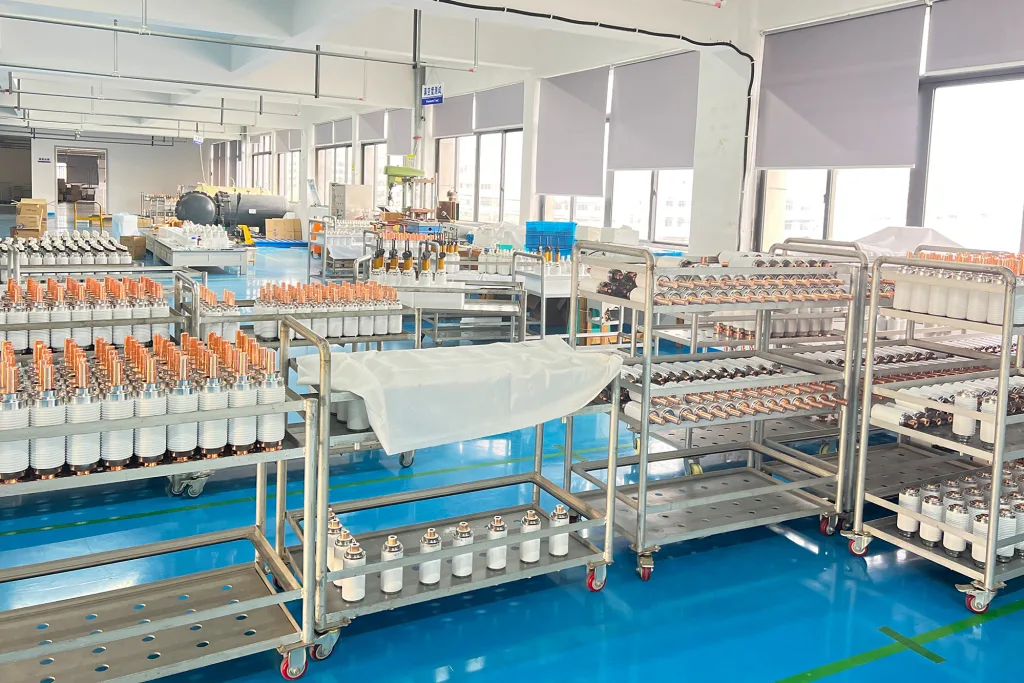Comparison of Vacuum Interrupter and SF6 Gas Insulation: Price and Performance Analysis
1. Introduction
Circuit breakers are critical components in electrical power systems, designed to interrupt current flow during faults and ensure system reliability. Two prominent technologies used in medium and high-voltage circuit breakers are vacuum interrupters (VI) and sulfur hexafluoride (SF6) gas insulation. Both technologies have distinct advantages and disadvantages in terms of performance, cost, environmental impact, and application suitability.
This paper provides a detailed comparison between vacuum interrupters and SF6 gas-insulated circuit breakers, focusing on their operating principles, performance characteristics, cost factors, and suitability for different applications.
2. Operating Principles
2.1 Vacuum Interrupter (VI)
A vacuum interrupter relies on a high-vacuum environment (typically below 10⁻⁴ Pa) to extinguish the arc when the contacts separate. The key features include:
-
Arc Extinction: In a vacuum, the arc plasma rapidly deionizes due to the absence of gas molecules, leading to quick arc quenching.
-
Contact Materials: Special alloys (e.g., CuCr) are used to withstand high temperatures and reduce contact erosion.
-
Compact Design: Vacuum interrupters are smaller and require less maintenance compared to gas-insulated alternatives.
2.2 SF6 Gas Insulation
SF6 circuit breakers use sulfur hexafluoride (SF6), an electronegative gas with excellent dielectric and arc-quenching properties:
-
Arc Extinction: SF6 captures free electrons, forming negative ions that rapidly deionize the arc plasma.
-
High Dielectric Strength: SF6 has about 3 times the dielectric strength of air, allowing for compact designs at high voltages.
-
Pressure-Dependent Performance: The gas must be maintained at optimal pressure for effective insulation and interruption.
3. Performance Comparison
3.1 Dielectric Strength
-
Vacuum Interrupter:
-
Excellent dielectric recovery after current interruption.
-
Limited only by contact material and vacuum integrity.
-
Best for medium-voltage (up to 38 kV) applications, though high-voltage versions (up to 245 kV) exist.
-
-
SF6 Circuit Breaker:
-
Superior dielectric strength, especially at high voltages (72.5 kV and above).
-
Maintains consistent performance over a wide pressure range.
-
3.2 Arc Quenching Capability
-
Vacuum:
-
Extremely fast arc extinction (within 1-2 current zero crossings).
-
No risk of gas decomposition or byproducts.
-
-
SF6:
-
Highly effective arc quenching due to SF6’s thermal conductivity and electron absorption.
-
Requires proper gas handling to avoid decomposition into toxic byproducts (e.g., SOF2, SF4).
-
3.3 Switching Performance
-
Vacuum Interrupter:
-
Excellent for frequent switching (e.g., capacitor banks, motors).
-
Minimal contact wear, leading to long service life.
-
-
SF6 Circuit Breaker:
-
Better for high fault currents (up to 63 kA or more).
-
May experience gas degradation over time, requiring monitoring.
-
3.4 Environmental Impact
-
Vacuum:
-
Eco-friendly (no greenhouse gas emissions).
-
No disposal issues.
-
-
SF6:
-
Extremely high global warming potential (GWP = 23,500x CO2).
-
Subject to strict regulations (e.g., EU F-Gas Regulation).
-
4. Cost Analysis
4.1 Initial Costs
-
Vacuum Interrupter:
-
Lower manufacturing costs due to simpler construction.
-
No gas handling or sealing requirements.
-
Cheaper for medium-voltage applications (up to 38 kV).
-
-
SF6 Circuit Breaker:
-
Higher initial cost due to gas containment systems, pressure monitoring, and sealing mechanisms.
-
More economical for ultra-high voltage (UHV) systems (≥ 245 kV).
-
4.2 Maintenance Costs
-
Vacuum Interrupter:
-
Minimal maintenance (no gas leaks, no refilling).
-
Only periodic contact inspection required.
-
-
SF6 Circuit Breaker:
-
Higher maintenance costs (gas leakage checks, refilling, decomposition byproduct management).
-
Requires specialized handling equipment due to environmental regulations.
-
4.3 Lifecycle Costs
-
Vacuum:
-
Lower total cost of ownership (TCO) for medium-voltage applications.
-
No regulatory penalties related to emissions.
-
-
SF6:
-
Higher TCO due to gas replacement, monitoring, and potential future bans.
-
Increasing costs due to carbon taxes and SF6 phase-out policies in some regions.
-
5. Application Suitability
5.1 Vacuum Interrupter Preferred For:
-
Medium-voltage distribution (1–38 kV).
-
Indoor installations (compact, no gas leakage risk).
-
Frequent switching (e.g., industrial plants, renewable energy systems).
5.2 SF6 Circuit Breaker Preferred For:
-
High-voltage and ultra-high-voltage transmission (72.5 kV–800 kV).
-
Outdoor substations (where gas handling is manageable).
-
High fault current interruption (≥ 50 kA).
6. Future Trends
-
Vacuum Technology:
-
Expanding into higher voltage ranges (145 kV+) with advanced contact materials.
-
Increasing adoption due to environmental regulations.
-
-
SF6 Alternatives:
-
Development of SF6-free gases (e.g., fluoronitriles, CO2 mixtures).
-
Hybrid designs combining vacuum interruption with alternative gases.
-
7. Conclusion
| Factor | Vacuum Interrupter | SF6 Circuit Breaker |
|---|---|---|
| Dielectric Strength | Good (up to 38 kV) | Excellent (≥ 72.5 kV) |
| Arc Quenching Speed | Very fast | Fast |
| Environmental Impact | Zero emissions | High GWP |
| Initial Cost | Lower | Higher |
| Maintenance Cost | Low | High |
| Best For | Medium-voltage, frequent switching | High-voltage, high fault current |
-
Vacuum interrupters are more cost-effective and environmentally friendly for medium-voltage applications, with lower lifecycle costs.
-
SF6 circuit breakers remain dominant in high-voltage transmission due to superior dielectric performance but face regulatory challenges.
The choice between the two depends on voltage level, switching frequency, environmental policies, and budget constraints. As vacuum technology advances and SF6 alternatives emerge, the industry is shifting toward more sustainable solutions.
